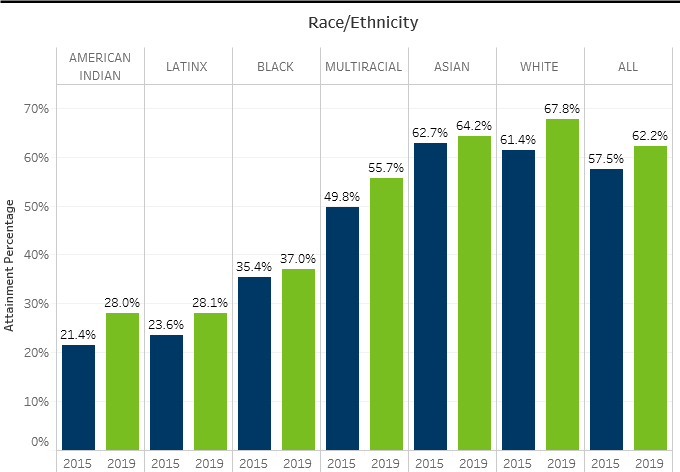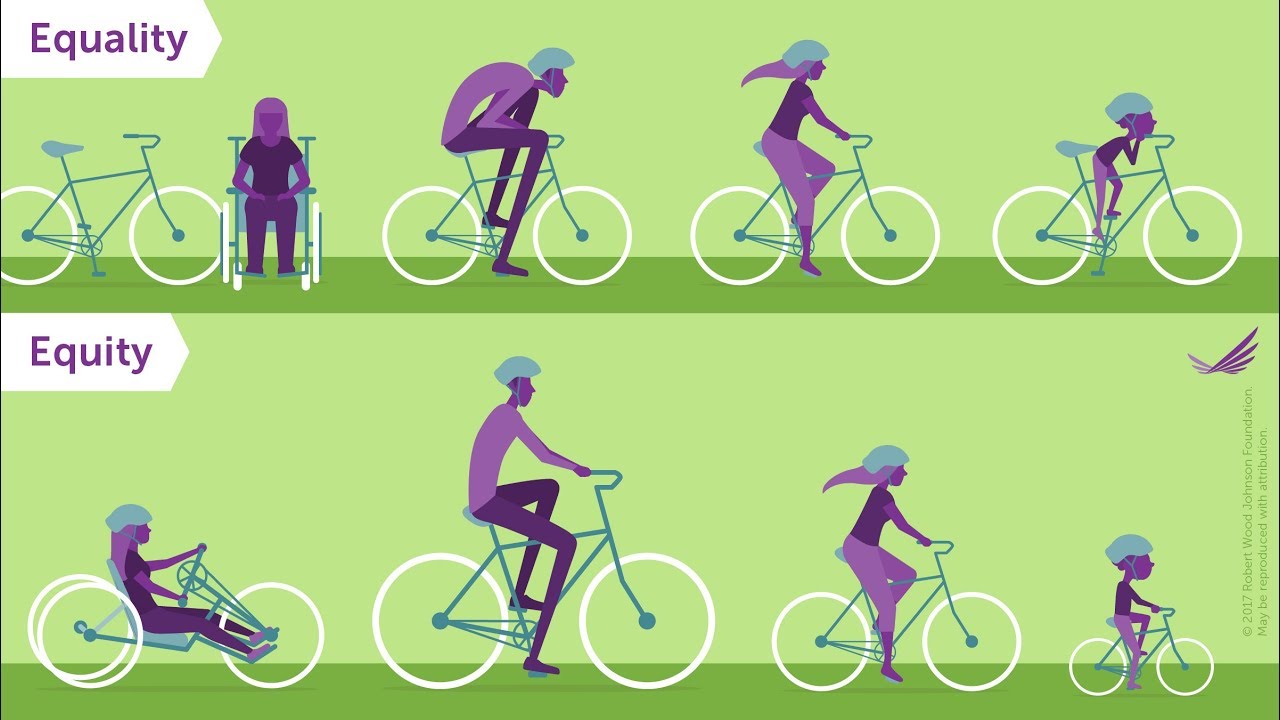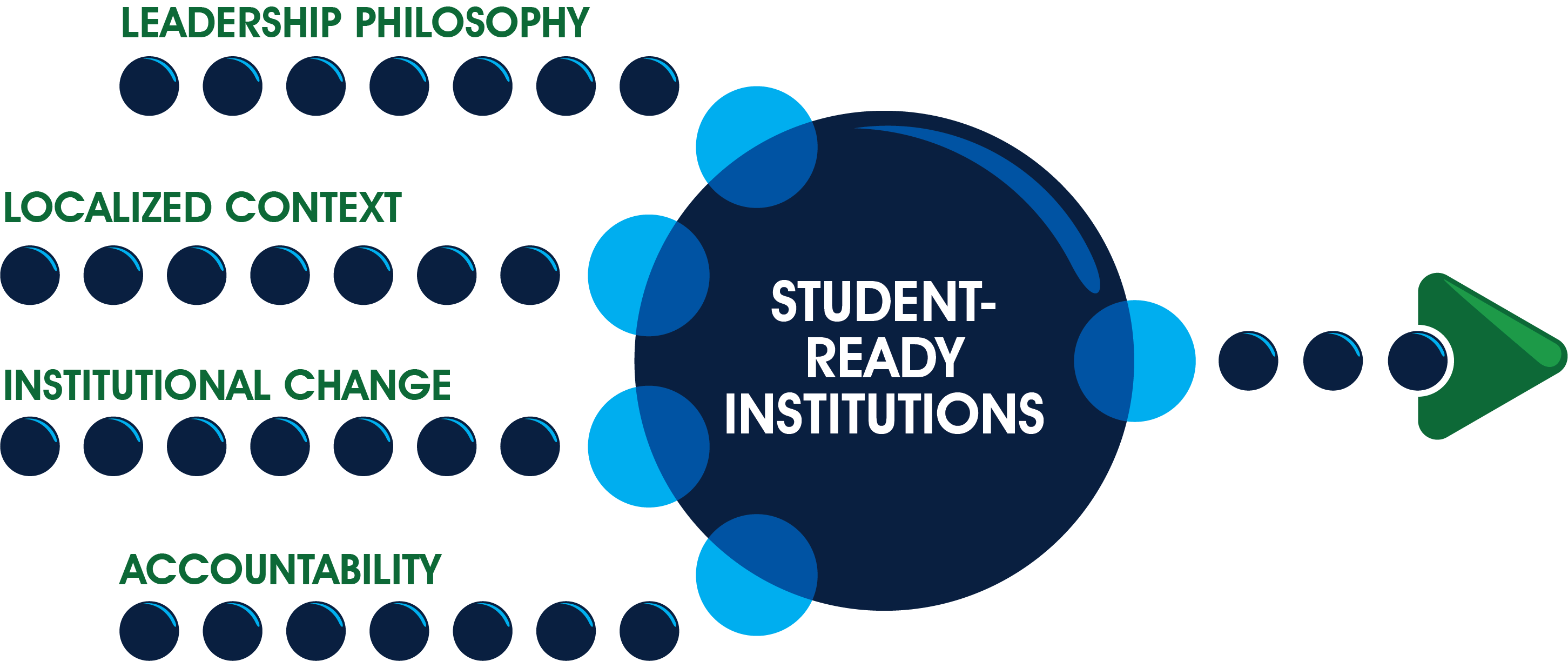Equity by Design at M State
Advancing the cause of equity
Equity by Design is a collaborative effort and commitment to advancing greater equity in the academic success of Minnesota State students and reflects our commitment to advancing equity, diversity and inclusion.
Background
In 2015, the Minnesota Legislature established an important goal for increasing the educational attainment of its population: By 2025, 70 percent of adults ages 25 to 44 across all racial and ethnic groups would have attained a postsecondary certificate or degree.
Severe racial equity gaps in educational attainment still exist (see the Race/Ethnicity graph below). Given the demographic shifts within the state, it is critical that these equity gaps be closed in order to reach Minnesota’s 70 percent attainment goal.
Minnesota State colleges and universities is the third largest system of community and technical colleges in the United States and the largest in the state with 30 colleges, seven universities and 54 campuses. Minnesota State colleges and universities serve 350,000-plus students each year, with more students of color and Native/Indigenous students attending its colleges and universities than all other higher education providers in Minnesota combined.
Minnesota State is well suited to address educational disparities and close academic equity gaps.

Minnesota Office of Higher Education.
Equality vs. Equity
Equity is ...
When an individual’s race, gender, economic status, sexual orientation, etc. do not determine their educational, economic, social, or political opportunities.
Equity prioritizes…
Leveling the playing field, ensuring the starting line does not determine where one finishes.

Minnesota State Equity 2030
Minnesota State’s guiding principle of Equity 2030 aims to eliminate educational equity gaps at all Minnesota State colleges and universities by 2030.
Equity by Design is one of many tools available to campuses to aid in actualizing the goals of Equity 2030.
Equity by Design prioritizes:
- Leadership philosophy
- Localized context
- Institutional change
- Accountability

Outcomes
Campuses that implement the Equity by Design methodology should expect the following outcomes to be achieved:
- The identification of student populations that are impacted by the completion gaps
- Utilization of an equity-lens approach to impact retention and/or completion gaps throughout Minnesota State
- Recommendations for equity-minded approaches to address student retention, completion rates, and/or other areas of focus, especially in the areas of curriculum and pedagogy
- Remediate practices and policies that are found to be detrimental to equity in outcomes
- A renewed focus on institutional-level policies, culture, and structures that aim to achieve equity in academic outcomes
“Being equity-minded thus involves being conscious of the ways that higher education -- through its practices, policies, expectations and unspoken rules -- places responsibility for student success on the very groups that have experienced marginalization, rather than on individuals and institutions whose responsibility it is to remedy that marginalization."
Witham et al. (2015)
Equity-minded individuals are…
- Color-conscious (as opposed to color blind)
- Aware that beliefs, expectations and practices assumed to be neutral can have outcomes that are racially disadvantageous
- Willing to assume responsibility for the elimination of inequality
Bensimon, Dowd & Witham (2016)
Reframing language: Deficit-minded versus equity-minded
A common example of deficit-minded language often used in higher education is the examination of “achievement gaps.” By characterizing disparities as “achievement gaps,” it places the onus on the students (typically from marginalized groups) by implying they are somehow failing to “achieve” (McNair et al, 2020).
An equity-minded approach to the same data would characterize the disparities as “equity gaps,” thereby placing the onus on correcting the disparities on the college or university.
A central tenet of Equity by Design is engaging students in the work, which goes beyond mere engagement and instead understands that students are assets to the work and their experience on campus. Informed by Yosso’s (2005) Model of Cultural Wealth, we remind ourselves that Minnesota State students:
- Possess cultural knowledge nurtured by family and community.
- Have the ability to maintain hopes and dreams for their future, despite perceived barriers.
- Have bicultural/multicultural skills attained through communication and experiences in more than one language or style.
- Hold networks of people and community resources.
- Have developed skills for maneuvering social institutions.
Race-conscious inquiry
- It is never a question of "Are my practices working?" It is always a question of "Who are my practices working for?"
- Who/what is being valued?
- What attitudes, behaviors and emotions are students being asked to adopt?
- Are there racialized patterns? Professor James Gray
Community College of Aurora, CO
